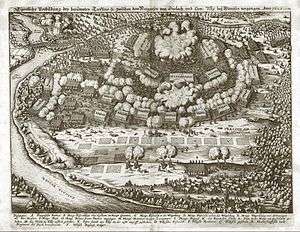Battle of Wimpfen
| Battle of Wimpfen | |||||||
|---|---|---|---|---|---|---|---|
| Part of the Thirty Years' War | |||||||
 The Battle of Wimpfen. Etching from Matthäus Merian's Theatrum Europaeum. | |||||||
| |||||||
| Belligerents | |||||||
| Protestant Union |
| ||||||
| Commanders and leaders | |||||||
| Georg Friedrich of Baden-Durlach |
Johan Tzerclaes, Count of Tilly Gonzalo Fernández de Córdoba | ||||||
| Strength | |||||||
|
10, 404+ Of which 404 are cavalry. Two 60 pounder guns, One 70 pounder, 20 of a mixture of 3, 5, 6 and 8 pounders and 6 "newly cast' guns and 9 half culverins[1] |
Approx: 15, 650+ 8,700 infantry, 900 cavalry, seven 12 pounders and 1 half culverin with Tilly. 5,200 infantry, 850 cavalry and five 8 pounders with Spanish.[2] | ||||||
| Casualties and losses | |||||||
| 12,000+ | 3,900-4,400 | ||||||
The Battle of Wimpfen was a battle in the Bohemian Revolt period of the Thirty Years' War on 6 May 1622 near Wimpfen. The forces of the Holy Roman Empire and Catholic League under Marshal Tilly and Gonzalo de Córdoba defeated the Protestant forces of General Ernst von Mansfeld and Georg Friedrich, Margrave of Baden-Durlach.
After the fall of the Bohemian capital of Prague following the Battle of White Mountain, Georg Friedrich decided to continue the battle and oppose Tilly and Cordoba at Wimpfen.
By early May, the forces of Christian of Brunswick had arrived to the north of the Neckar River and were prepared to assist the Protestant forces. This came as good news to the combined forces of Mansfeld and Georg Friedrich, who hoped to combine their armies before risking a major battle.
To gain time and to attempt to split the combined Catholic army, Mansfeld crossed the Neckar near Heidelberg while Georg Friedrich marched east up the river to cross at Wimpfen. The plan failed as the troops under Tilly and Córdoba did not split and instead pursued the 14,000 strong army of Georg Friedrich and cut him off near Wimpfen. Outnumbered, the margrave deployed his troops into a defensive position on a low hill outside of the village. Here the Protestants made an effective stand, rallied by a strong artillery position until a random Spanish countershot exploded the Protestant magazine, costing the Badeners their position. The Catholics drove the hill and shattered the Protestant army. Baden-Durlach then fled to Stuttgart with but a few remaining men under his command.
Meanwhile, Mansfeld was hurriedly trying to meet up with Christian who was positioned at the Main; Córdoba and Tilly were in hot pursuit to keep this junction from occurring.
The story of the 400 citizens of Pforzheim who sacrificed themselves for their prince after the battle has been shown by modern research to be a myth.
Coordinates: 49°11′50″N 9°10′20″E / 49.19722°N 9.17222°E